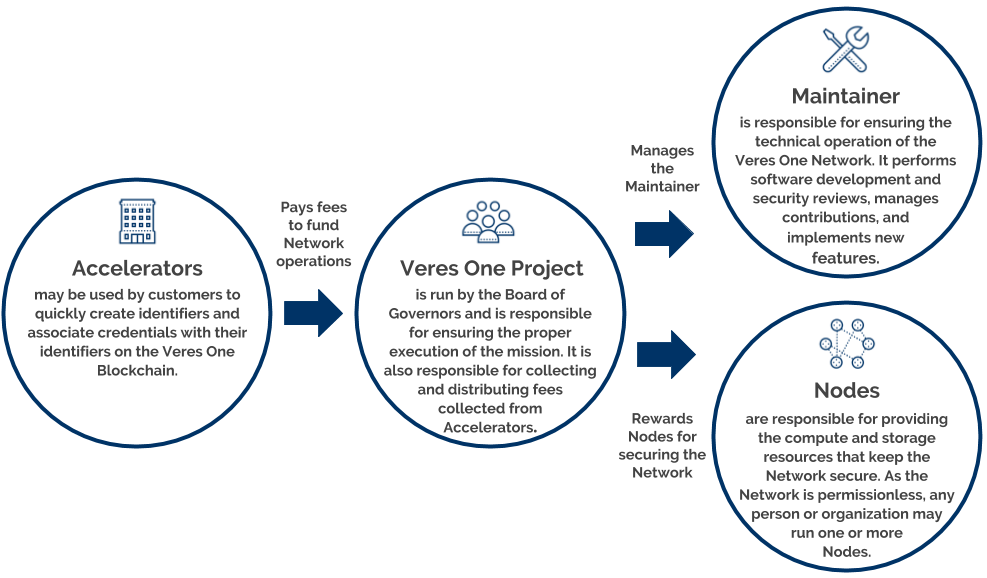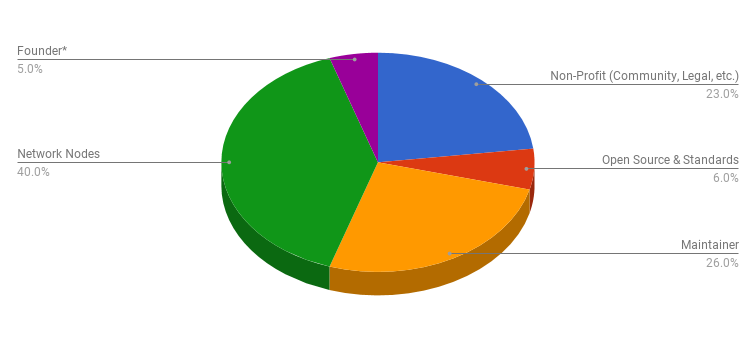Contributors: Manu Sporny, David Longley, Kaliya Young, Joe Andrieu, Pindar Wong, Kim Hamilton Duffy, David Ezell, Dan Burnett, David Wood, Jim Norton, and Chris Webber
The Veres One Project envisions a world where people and organizations control their identifiers and their identity data. The Veres One Blockchain is the worlds first public, permissionless, fit-for-purpose blockchain optimized for identity on the Web.
The Vision of the Veres One Project is to enable all people and organizations in the world to
-
create and own their online identifiers, and
-
control their identity data and with whom they share that data.
Achieving this vision will enable a Web where:
-
Our identity information and identifiers are owned and controlled by each of us.
-
We can more strongly prove key attributes about our digital personas, reducing fraud.
-
Data can be bound to identifiers under our control instead of only to websites, or stuck on paper in file cabinets, improving data portability.
-
Privacy can be enhanced by choosing when and with whom our information is shared.
-
Data sharing can be more easily reduced to the minimum required for a given interaction.
This vision is shared among a large community of people working within global organizations such as the Internet Identity Workshop, World Wide Web Consortium, Internet Engineering Task Force, United Nations ID2020, the Decentralized Identity Foundation and the Rebooting the Web of Trust project. Veres One is a realization of this Vision and we are eternally thankful to the communities that helped shape this project from the very beginning.
The Veres One Blockchain is a fit-for-purpose blockchain built specifically for Decentralized Identifiers. This specialization enables the blockchain to be faster, more cost effective, and more privacy enhancing compared to existing blockchains that are being repurposed for identity management. The Veres One Network is:
-
Public - Anyone in the world may read and audit the entire contents of the ledger.
-
Permissionless - Any person or organization in the world may create and control their identifiers.
-
Leaderless - Blockchain consensus relies on leaderless elector collaboration, not proof of work, to determine when consensus has been finalized. Electors are selected dynamically to allow participants to join and leave the network and to ensure that there is no centralization or single point of failure for the ledger.
-
**Based entirely on open standards and open specifications **- Broad implementation and interoperability can only be achieved if all aspects of the system are documented and standardized in a non-discriminatory, patent-free and royalty-free manner while ensuring that the creators and maintainers of the system are properly funded.
-
Built on a stakeholder driven governance model - The source code and development team have a strict mission-driven focus that always puts the users of the ledger first.
-
Economically sustainable - The people that create, run, and protect the network are paid by the Veres One Project to do so. Avoiding a "tragedy of the commons" is essential for sound network economics for a global public utility.
-
Non-speculative - Unlike other ledgers, the Veres One Blockchain does not need a speculative network token or cryptocurrency, which eliminates currency speculation, thus ensuring predictable long term operational costs.
The Veres One Network consists of a number of roles:
-
The Board of Governors is responsible for governance. This includes ensuring the proper execution of the Veres One Project mission and managing, collecting, and distributing funds according to the funding model.
-
The Maintainer is responsible for maintaining the Veres One software including continuous security review, managing community contributions, correcting software defects, and implementing new features.
-
Nodes are responsible for providing computational and storage resources for the Network. As the system is permissionless, any person or organization may run one or more Nodes.
-
The Network is a collection of Nodes that maintain the decentralized ledger.
-
Entities (people, organizations, and devices) use the Network to create and update decentralized identifiers and their associated metadata.
-
Accelerators enable entities to increase the speed at which Entities can create and update identifiers on the Network.
Entities may use the Veres One Network to create decentralized identifiers via software applications such as digital wallets. There are two mechanisms for creating Decentralized Identifiers on the Network. Both mechanisms require roughly $1 USD to perform, which is derived from the estimated cost of running the Network. Updates to the Decentralized Identifier require roughly $0.25 USD to perform or between 2%-4% of what the Accelerator charges to write a particular type of data to the blockchain, whichever is greater.
The first approach is to pay an Accelerator to create a Decentralized Identifier, which happens as quickly as the Network can come to consensus (a few minutes).
The second mechanism is to submit a creation request to the Network with an associated proof of work, which typically takes 6-9 hours for a software application to generate. Once the Network verifies the proof of work and comes to consensus, the Decentralized Identifier will be created.
The Veres One Project collects proceeds from Accelerators at agreed upon rates set by the Board of Governors and distributes the funds according to current operational needs.
Accelerators fees will be waived on a recurring basis for a fixed number of humanitarian uses, such as providing portable digital credentials to refugees for asylum-seeking purposes.
A select number of features and characteristics of the Veres One blockchain are listed below:
| Feature | Description |
|---|---|
| Internal Data Model | Linked Data + Web Ledger |
| Supported Key Types | RSA 2048-4096, Ed25519 |
| Gossip Algorithm | biased, logarithmic reduction |
| Consensus Algorithm | Continuity - Leaderless, byzantine fault tolerant, asynchronous without rounds, non-blocking, consensus with probability 1 |
| Write Fault Tolerance | 3f + 1 (f == number of byzantine faults) |
| Elector Model | Dynamic, rotating attack surface |
| Throughput | 209 DIDs/sec, 18M DIDs/day, 6.6B DIDs/year |
| Consensus Latency | ~15-30 seconds |
Readers that would like to dive into the technical details should read the Veres One DID Method paper.
You can learn more about this project by visiting the Veres One Website.

